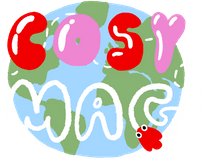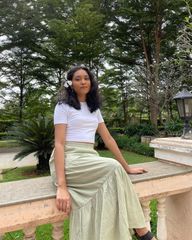Dopamine dressing is a term that has been circulating in fashion spaces on social media in recent years as a concept that plays a role in explaining how clothing has a direct impact on our mood.
Fashion plays a role in everything we do, whether we like it or not. As cliché as it is, it is a form of self-expression that ultimately influences the way we carry ourselves and also how we are perceived by others.
Dopamine dressing is a term popularized by Dawnn Karen, a fashion psychologist, that was dubbed by Pinterest as a 2022 trend. Pinterest claimed that “dressing loud is the new dressing down”. Clothing can be used to catalyze a dopamine spike— dopamine being the neurotransmitter that plays a role in pleasure and happiness. In its essence, it highlights that our clothing style can cause an uplifting of our mood; Karen questions the release of dopamine by “wearing something crazy, whimsical stuff that doesn’t match, polka dot or leopard print, tutus, or bright colours”. Designers of late have used this concept in their runway shows, an ode to the joy faced by many after a rough few years.
Maria Costantino, a lecturer at the London College of Fashion, explains that “when dopamine is released in large amounts, it creates feelings of pleasure and reward, which motivates us to repeat a specific behaviour”. In the case of dopamine dressing, this could extend to our habits of buying or wearing new clothes which ultimately make us happier. Confidence is something that comes with feeling joyous about the way we look and can be related to the colours, prints, or textures that we feel drawn to.

Karen Pine, a psychologist, elaborates that there are psychological connections to specific colours and textures. Hence, what we wear can affect how we feel to the point that “it can distort and determine our thoughts and judgments”. Enclothed cognition, as told in a report by Hajo Adam and Adam Galinsky, is a term created to demonstrate the relationship between the symbolic meaning of clothes and the physical experience of wearing them. It was found that clothes systemically influence the wearer's psychological processes, for example, performance on tasks is enhanced.
The most recent example is the Pierpaolo Piccioli collection for Valentino in the AW22 women’s season or the “Pink PP” collection. According to the fashion house, the colour pink is a “manifestation of the unconscious and a liberation from the need for realism”. Since everything in the show was pink — the floors, seats, stairs and even the outfits —it allows the personality of the person to shine through. The colour, which was worked on with the Pantone Color Institute, references pop culture staples such as Mean Girls or Legally Blonde.

Following colour therapy in fashion, pink is a colour used to invoke lively energy. Lauren Adhav for Cosmopolitan explains that colour can impact our emotional state – receptors in our retina shoot a signal to the brain through the optic nerve that allows us to understand what colour the object is and what emotions may be felt from that colour. Designers are now intentionally choosing certain colours in their collections to invoke certain feelings in their customers and, in the case of Piccioli, he was able to create a brand identity with his signature pink colour.
John Galliano has said that “the joy of dressing is an art, but so is the craftsmanship and making of the dress”. In recent times, handcrafting such as knitting or crocheting has made its rounds among women on TikTok. Alison Foreman for Mashable highlights some of the experiences that people have had with crocheting as a quarantine hobby that led to it being a business or a side hustle. More importantly, however, crocheting has become a way to release any negative emotions from the daily stressors of life. These hobbies have allowed people to have a unique sense of style that stands out, which is difficult to do in the times of fast fashion brands and short trend cycles. Hence, craftiness is a large part of developing one’s own personal style but beyond that, developing hobbies can improve our mental state due to the release of dopamine. Having unique pieces that you have handcrafted can lead to a sense of fulfilment as well.
Thalia Castro-Vega, a stylist and content creator under the Instagram handle polychrom3, weighs in on what dopamine dressing and fashion mean to them. Their self-described "hyper-femme maximalist business professional" fashion sense combined with their vibrant and electric energy has allowed them to garner over 110,000 followers on Instagram. They love feminine clothing and combining it with the rigidity of tailored suits to come up with copious amounts of fun.

Fashion has always been a part of their life. During their childhood, they had a limited wardrobe but unlimited creativity. “During the summer, prior to school starting, I would gather up all my clothing and think of new ways to combine them and style them in unique ways. I frequently would turn my tops into skirts to give me more versatility and wear. I took up content creating over 2 years ago.” Their childhood was also when they started styling others: “I would go into my family members' closets and pick out their outfits for them and provide insight on what to invest in”.
However, this became their career a few years ago after being convinced by a friend. “I had worked in fashion in some capacity for a number of years, so doing it independently felt very natural. Working with clients helps me see even more of the potential the fashion industry has to improve. We are used to outdated archetypes of how we are “supposed” to dress, but those rules are arbitrary. My goal is to help each client free themselves of whatever rule was embedded into their thinking, and embolden them to try something they otherwise wouldn’t have. For instance, a lot of people want to know the “right” colours to wear. And of course, I can provide that insight but it is based off of old rules. Instead, I try to encourage them to pick the colours they love, and help them integrate that into their wardrobe.”
To them, the meaning of fashion is art, “besides serving its practical purpose of clothing us. It quite literally had to be made by someone, they had a creative idea and wanted to physically manifest it into something people can wear over and over. I love maximalism because it really invoked the meaning of fashion as an art form. I have no qualms with a basic t-shirt and jeans, but when I am dressed in a maximalist way - wearing ruffles, or interesting textures with unique patterns and fun colours, then I feel like a walking piece of art while simultaneously meeting the practical need of clothing myself. Maximalism brings joy to my life.”
Confidence was something they came out of the womb with. They knew they were different and would never blend in with their peers. “When I was in middle and high school, my peers were wearing Hollister and Aeropostale t-shirts with jeans, but I showed up to school wearing a full-on ruffled lace dress or a jumpsuit with knee-high boots. I was already made fun of for my lisp and hair (amongst other things).” This sense of conviction wavered as they grew older due to a number of serious life events, however knowing the way they style clothing is art brought back their confidence; “Being an adult comes with its own set of restrictions, in terms of dress, but I always try to find a way past it.”
To Thalia, dopamine dressing is “dressing in a way that brings you joy. It is typically colourful and has this pervasive air of innocence.” Though maximalism can be included in dopamine dressing, they state that they would not describe themselves as a dopamine dresser outright. However, “if I want to partake in the aesthetic, then I would choose bright colours with floral print and my favourite pair of platform shoes”. Further, it is important to note that maximalism and dopamine dressing are not necessarily linked with one another.
So, how can we incorporate this lifestyle into our everyday life?
“Grant yourself grace to joyfully express yourself the way you see fit. Giving yourself grace to try new things and recognizing that most people will not care about how you dress. I would recommend any lifestyle or personal style that brings someone joy. If dressing in bright and happy clothing is a contributing factor to their joy, I highly recommend it.”
A way to engage in this can be through using colour theory which “creates such beautiful combinations, and I like creating a sense of cohesion with my maximalist looks.”
It's important to remember that this lifestyle does not encourage overconsumption. Castro-Vega tells us that “any style of dress can go in hand with sustainability but only if the consumer is being mindful of how they consume. If someone wants to dopamine dress, then they need to do the mental work to determine if that style truly aligns with how they want to present themself. From there, being mindful of how purchases are made is important. Buy only what truly speaks to you, and matches your lifestyle and needs.
Hauls can be a deciding factor for audiences on social media to go out and purchase a product. As they define it, “hauls are intended as content to produce consumption. If you see a haul from a content creator for a brand (commonly Amazon), then you immediately want to buy into it. Consumption is a part of human nature. If you see a haul telling you how amazing a product is, you want to buy into the level of happiness or joy. Because hauls are frequent pieces of content, the consumption never ends — people will see it, want it, and buy it.”
When asked for some advice on how to be more mindful consumers, they mention that “shopping isn’t about where you consume, it’s about how you consume. Waiting 1-3 days before you buy something can help “cool you down” and allow you to process if you really need it. Considering what you own and how you can utilize it to your benefit can help determine if the product in your cart is a necessity or not.”















